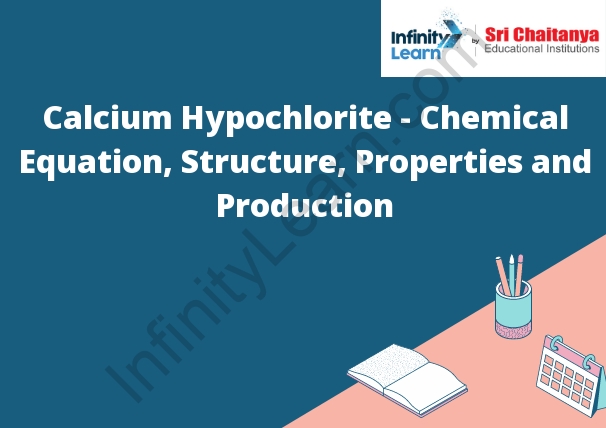Table of Contents
What is Calcium Hypochlorite?
Calcium Hypochlorite – Chemical Equation: Calcium hypochlorite is a water-soluble chemical compound that is used as a disinfectant and a bleaching agent. It is produced by the reaction of chlorine with calcium hydroxide.
Calcium hypochlorite is used as a disinfectant for drinking water, swimming pools, and wastewater. It is also used as a bleaching agent for textiles and paper. Calcium hypochlorite is a white crystalline solid that is slightly soluble in water. It is toxic if ingested and can cause skin and eye irritation.
Ca(ClO)2 + 2 H2O -> Ca(OH)2 + 2 HCl
Calcium hypochlorite is a white solid that is soluble in water. When it is dissolved in water, it produces calcium hydroxide and chlorine gas.
Properties of Calcium Hypochlorite
Calcium hypochlorite is an inorganic compound with the formula Ca(ClO)2. It is a white solid that is slightly soluble in water. It is produced on a large scale as a precursor to chlorine dioxide.
Calcium hypochlorite is a precursor to chlorine dioxide. It is produced by the reaction of chlorine gas with calcium hydroxide:
2Cl2(g) + Ca(OH)2(aq) → CaCl2(aq) + 2H2O(l) + 2O2(g)
Chlorine dioxide is a strong oxidizing agent that is used for water treatment and bleaching.
Uses of Calcium Hypochlorite
- Calcium hypochlorite is a white crystalline powder.
- It is a chlorinated derivative of calcium hydroxide.
- It is soluble in water and has a chlorine odor.
- It is used as a disinfectant and bleach.
- It is also used as a water treatment chemical.

Calcium Hypochlorite Chemical Equation-
The calcium hypochlorite chemical equation is as follows:
Ca(ClO)2(aq) + 2H2O(l) → Ca(OH)2(aq) + 2HOCl(aq)
In this equation, calcium hypochlorite (Ca(ClO)2) is the reactant and calcium hydroxide (Ca(OH)2) is the product. Additionally, hypochlorous acid (HOCl) and water (H2O) are also produced as byproducts.
Structure of Calcium Hypochlorite
- Calcium hypochlorite is an inorganic compound with the formula Ca(ClO)2. It is a white solid that is slightly soluble in water. It is produced by the reaction of chlorine dioxide with calcium hydroxide.
- The compound is a salt consisting of a calcium cation and a hypochlorite anion. The calcium cation is coordinated to six oxygen atoms in a distorted octahedral geometry. The hypochlorite anion is linear and is bonded to the calcium cation via oxygen atoms.
Physical Properties of Diamond
- Diamond is the hardest natural material known. It has a hardness of 10 on the Mohs scale, meaning it can scratch all other materials. It is also a good conductor of heat and electricity. Diamonds are usually transparent but can also be colorless, yellow, brown, or black.
- Diamond is the hardest natural substance known to man. It is found in the form of a mineral and is composed of carbon. Diamond is the most popular gemstone and is used in jewelry and other decorative items.
- The physical properties of diamond include its hardness, its high thermal conductivity, and its high optical reflectivity. Diamond is the hardest natural substance known to man. It has a hardness of 10 on the Mohs scale, which is a scale that measures the hardness of minerals. It can only be scratched by other diamonds.
- Diamond is also a good thermal conductor. This means that it can conduct heat very well. This is why diamonds are often used in jewelry settings that are in close contact with the skin, such as rings and earrings. Diamonds do not tarnish or corrode and they are very resistant to scratches. They also have a high optical reflectivity. This means that they reflect a lot of light and they sparkle.
Chemical Properties
The chemical properties of magnesium are very reactive. Magnesium is a silvery-white metal that is very light and flammable. Magnesium is also very corrosive, meaning it can easily react with other substances and wear away. Chemical properties are the characteristics that a substance has due to the atoms that make it up. These properties depend on the types of atoms present, the number of each type of atom, and how the atoms are arranged. For example, a substance made of hydrogen and oxygen atoms will have very different chemical properties than one made of carbon atoms.
Production of Calcium Hypochlorite
The main production process of calcium hypochlorite is the chlorination of lime. In this process, calcium oxide is reacted with chlorine gas to form calcium hypochlorite and water.
The reaction equation is:
CaO (s) + Cl2 (g) → CaCl2 (aq) + H2O (l)
The process can be summarized in the following steps:
1. calcium oxide is produced by heating calcium carbonate
2. chlorine gas is bubbled through the calcium oxide
3. calcium hypochlorite and water are produced
Calcium Hypochlorite Uses
- The main use for calcium hypochlorite is as a disinfectant and bleaching agent. It is also used to make other chemicals, including chloroform and trichloroacetic acid.
- Calcium hypochlorite is a chemical compound with the formula Ca(ClO)2. It is a white solid that is very soluble in water. It is used as a disinfectant, bleaching agent, and oxidizing agent.
- One of the most common uses of calcium hypochlorite is as a disinfectant. It is used to kill bacteria, viruses, and other microorganisms. It can be used in a variety of settings, including hospitals, schools, and homes.
- Another common use of calcium hypochlorite is as a bleaching agent. It can be used to bleach fabrics, paper, and other materials.
- Calcium hypochlorite is also used as an oxidizing agent. It can be used to oxidize organic compounds, including pollutants. This makes it a useful tool for cleaning up environmental messes.








